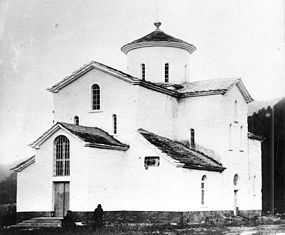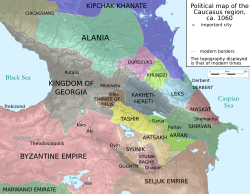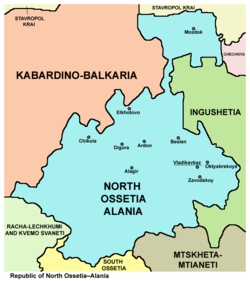History of North Ossetia–Alania

TheRepublic of North Ossetia – Alaniais afederal subjectofRussia(arepublic), located in theCaucasusregion.
Early history
[edit]



The territory of North Ossetia has been inhabited for thousands of years, being both a very fertile agricultural region and a key trade route through theCaucasus Mountains.The ancestors of the present inhabitants were a people called theAlans,[1]a warlike nomadic people who spoke anIranian language.[1]Part of the Alan people eventually settled in the Caucasus around the 7th century AD. By about the 9th century, the kingdom ofAlaniahad arisen and had been converted toChristianitybyByzantinemissionaries.An archbishopric was established in western Alania under the authority of thePatriarchate of Constantinople,and many large churches were constructed (Zelenchuk churches,Shoana Church,Senty Church). Alania became a powerful state in the Caucasus, profiting greatly from the legendarySilk RoadtoChina,which passed through its territory.
From theMiddle Agesonwards, Alania was beset by external enemies and suffered repeated invasions. The invasions of theMongolsandTatarsin the 13th century decimated the population, who were now known asOssetians.Islamwas introduced in the 17th century through theKabardians,a Muslim Caucasian people. Incursions by theKhanate of Crimeaand theOttoman Empireeventually pushed Alania/Ossetia into an alliance with Russia in the 18th century. North Ossetia was among the first areas of the northern Caucasus to come under Russian domination, starting in 1774, and the capital,Vladikavkaz,was the first Russian military outpost in the region.[2]By 1806, Ossetia was completely under Russian control.
Imperial Russia
[edit]The arrival ofImperial Russialed to the rapid development of the region, with industries founded and road and rail connections built to overcome Ossetia's isolation. TheGeorgian Military Road,which is still a crucial transport link across the mountains, was built in 1799 and a railway line was built from Vladikavkaz toRostov-on-Donin Russia proper. The Ossetians' traditional culture inevitably underwent someRussification,but their new connections with Russia and the West helped to boost local culture; the first books in the Ossetian language were printed in the late 18th century. In 1830, a military campaign led by GeneralIvan Abkhazovbrought North Ossetia under tighter control of the Russian Empire. The area became part of the Terskaya Region of Russia in the mid-19th century.
Russian Revolution and USSR
[edit]After theRussian Revolution,North Ossetia became part of the short-livedSoviet Mountain Republicin 1921. It became theNorth Ossetian Autonomous Oblaston July 7, 1924 and was then made theNorth Ossetian Autonomous Soviet Socialist Republic(ASSR), within theRussian Soviet Federated Socialist Republic,on December 5, 1936. InWorld War II,North Ossetia saw the high-water mark of the invasion of Russia byNazi Germany;the Germans attempted to seize Vladikavkaz in November 1942 but were repulsed.
During and after the war Stalin undertookmassive deportations of whole ethnicitiesexplaining this by anti-Sovietism, separatism and collaboration with Nazi Germany. In particular, this affectedBalkars,Chechens,andIngushs.As of 1944, the part of thePrigorodny Districton the right bank of theTerek Riverhad been part ofChechen-Ingush ASSR,but it was granted to North Ossetia in followingJoseph Stalin's deportation of the Chechens and Ingush toCentral Asia.Although they were eventually allowed to return from the exile, they were generally not allowed to settle in the original territories. Instead, in 1957, three districts ofStavropol Kraiwere granted to Chechen-Ingush ASSR. A local law passed in 1982 actually prohibited ethnic Ingush from obtaining residency permits in North Ossetia.
After the USSR
[edit]
North Ossetian SSR finally became the first autonomous republic of the RSFSR to declare national sovereignty[citation needed],on June 20, 1990 (although it still remains firmly part of Russia). In 1991, North Ossetian SSR was renamed the Republic of North Ossetia–Alania.
The dissolution of theSoviet Unionposed particular problems for the Ossetian people, which were divided between North Ossetia, which was part of the Russian SFSR, andSouth Ossetia,part of theGeorgian SSR.In December 1990 the Supreme Soviet of Georgia abolished the autonomous Ossetian enclave amid the risingethnic tensions in the region,and much of the population fled across the border to North Ossetia or Georgia proper. Some 70,000 South Ossetian refugees were resettled in North Ossetia, sparking clashes with the predominantly Ingush population in thePrigorodny District.That led toOssetian-Ingush conflict.
As well as dealing with the effects of the conflict in South Ossetia, North Ossetia has had to deal with refugees and the occasional spillover of fighting from the war in neighboringChechnya.The bloodiest incident by far was the September 2004Beslan hostage crisis,in which Muslim separatists ofShamil Basayevseized control of a school. In the firefight between the terrorists and Russian forces that ended the crisis, 335 civilians, the majority of them children, died.
See also
[edit]References
[edit]- ^abАланы,Great Soviet Encyclopedia
- ^Foltz, Richard(2022).The Ossetes: Modern-Day Scythians of the Caucasus.London: Bloomsbury. pp. 82–83.ISBN9780755618453.
